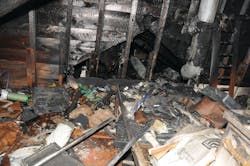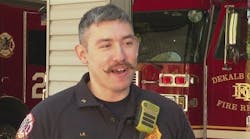This is the second column about a close call involving the Westfield, MA, Fire Department (WFD). During a March 30, 2012, fire in a single-family-dwelling, Captain Rebecca Boutin crawled into a smoke-filled attic moments after it had flashed over and rescued Firefighter Stephen Makos. Firefighter Makos, running low on air, was lost and disoriented in heavy fire and smoke.
Last month’s column featured Captain Boutin’s account of the incident. This month, we feature an account by Firefighter Makos and further observations about this close call.
My sincere appreciation to Captain Boutin, Fire Chief Mary R. Regan and Firefighter Makos. Additionally, thanks to Firefighters Ray Neilsen, Kevin Tracy and Joe Coach, all the officers and members of the WFD and the Holyoke and West Springfield fire departments.
This account is by Westfield Firefighter Steve Makos:
It’s funny how things can change so quickly. One minute, you are at the firehouse sitting around the kitchen table with your fellow firefighters, laughing, telling jokes and waiting for dinner and the next thing you know, you are low on air, disoriented, burned and don’t know if this is where you might spend the last moments of your life.
We received a call for a structure fire downtown. Captain Boutin gave us pre-arrival assignments while responding. My position was on the nozzle and to grab a set of irons (halligan and axe). Upon arrival, I noticed thick, black smoke from the attic, heaviest from the rear (C side). I extended a 1¾-inch line to an exterior B-side stairway and took over forcing entry through the door from a police officer. The door was difficult to force and another firefighter took over so that I could mask up and get ready to make entry. We advanced a dry line up the stairs to the second floor, where we found access to the attic stairwell. When we opened the door, we encountered thick smoke with no visibility. Captain Boutin called for water and we continued to advance to the top of the stairs. At the top, we were met with high heat and no visibility.
Entering the attic, there were no signs of fire, but high heat. We were thinking it was in the rear. Captain Boutin ordered the ceiling cooled until ventilation before we could consider advancing. I heard Captain Boutin updating the incident commander of high heat and asking about progress in ventilation. I could hear the crew working on the roof above us.
While operating the hoseline, I was knocked over. My mask was displaced and I developed a leak due to loss of seal in the mask. I made several attempts to re-position my mask, but I was still losing air. My low-air alarm sounded and I told Captain Boutin that I needed to change my bottle. I shut the bale down, moved past her and came off the line. I knew I was close to the exit because we had not advanced far into the attic. I became disoriented with no hoseline or wall and ended up moving away from the exit toward the center of the attic.
The heat became intense and I yelled out for Captain Boutin that I needed help getting out. I was thinking that other firefighters must be so close that they could hear me because I could hear them yelling for me. What I didn’t realize was that the heat and flame from the flash had forced them down the attic stairs.
Looking back, I realize that the second I knew I was lost and low on air I should have immediately called for a Mayday. I should not have assumed they were nearby. I kept feeling for a wall or structure, but I was having difficulty with self rescue and was worried about advancing farther into the attic. I eventually felt a solid kick to my shoulder, which was my captain searching for me. I climbed over her and bailed out head first, assisted by two other firefighters.
I’ve been told that other firefighters were never more than 10 to 12 feet from me, which is why I could hear their voices. It doesn’t matter if you are 50 feet or five feet from an exit – if you are in a toxic environment and your mask comes off, you’re going to die. I was low on air and hoping someone would find me. I remember not knowing if my next breath was going to suck my mask to my face. The biggest lesson I learned that day was to not second-guess calling for a Mayday. Don’t assume they know where you are.
Once outside, I was assisted with gear removal and received medical attention. I had singed hair and second-degree burns, despite the use of full turnout gear, including my hood and earflaps. I also had smoke inhalation and CO (carbon monoxide) exposure. I feel strongly that my captain, and friend, got me out of a situation that I could not get out of on my own and she saved my life.
Observations by Chief Goldfeder and others about this fire:
First, congratulations to Captain Rebecca Boutin for her heroic efforts at this fire. At the annual Massachusetts Firefighter of the Year ceremony, Governor Deval Patrick, Public Safety Secretary Mary Elizabeth Heffernan and Fire Marshal Stephan D. Coan presented Captain Boutin and 31 other firefighters with awards for heroism and community service.
“It’s a pretty weird feeling,” Boutin said, adding that she believes she did what any firefighter would have done. “That’s what we’re trained to do. It’s one of those things you read about. It was the kind of thing that a lot of people won’t run into in their careers.”
Seconds before the flashover, Firefighter Makos notified her that he was low on air. It wasn’t until after they scrambled out of the attic after the flashover that anyone knew Firefighter Makos never made it out.
“It was scary,” Captain Boutin said. “If it was a minute long, it was the scariest minute.” She said it was the first time in her career she feared for her life. “I never felt that way before. But I was more fearful for his life. He was in more of a dire situation than I was.”
When they got outside, both were burned through their protective clothing. Boutin had minor burns on her shoulder, while Makos had second-degree burns to his back and neck.
“He took on a lot of heat,” she said, adding that once he was outside, the air tank on his back was too hot to touch.
Fire Chief Mary R. Regan said it was clear that Captain Boutin saved Firefighter Makos’ life.
“After speaking to Steve about it, there is no question that he was not going to be able to make it out of the building (on his own),” Chief Regan said. The room rapidly filled with black smoke and visibility was about zero, she said. “From about six inches above the floor and up you couldn’t see anything, not even your hand in front of you,” she said. “It was a serious situation and she handled it perfectly.”
The scenario was so serious that afterward, the department brought in a crisis team to counsel anyone troubled at how close they had come to losing one of their own. “When you come that close to losing somebody, you deal with it head on,” Chief Regan said.
Every firefighter MUST train daily for that “worst day.” For the firefighters in Westfield, the day started with a relatively common fire, but as we all know, fires can turn out to be anything but, as happened in Westfield. This could have resulted in the death of a firefighter, but certain things happened so that it did not.
What are the three top measurable factors that resulted in Firefighter Makos’ life being saved?
1. Training
2. Training
3. Training
His training. Her training. The backup line crew’s training.
Let’s look at factors before, during and after the emergency:
• Staffing and roles – Like so many fire departments, the WFD has limited staffing. We can (and do!) get upset, emotional and angry – we should always to make sure we have what is needed to take care of our communities – but we still must do the best with what we have.
The WFD has appropriately pre-determined what roles can be performed with the staffing it has. Well before the fire, departments must identify what they can do to have the desired impact. For example, a department may WISH to have 30 firefighters on a first alarm, but when that is impossible, it must determine how many firefighters it will have on a first alarm and prioritize the tasks to be performed. These actions are based on size-up and identifying conditions, tasks to be performed and the resources to get them done. By pre-planning first-alarm assignments, we have fewer surprises when we arrive. Additionally, striking additional alarms as soon as possible (as the WFD deputy chief did) and automatic mutual aid on the first-alarm assignment for a reported fire can help get those tasks performed quicker.
• Police on the scene – Fire and police departments have a long history of well working well together – or not. The Westfield Fire and Police departments have a good relationship. When I read that police officers were forcing doors upon the arrival of the WFD, I raised my eyebrows over my head! Naturally, we understand that forcing doors (which includes a venting factor) can significantly impact our operations. It’s important that police officers understand how their well-intentioned actions may drastically and very negatively impact the fire, the occupants, the firefighters and, of course, their unprotected selves while attempting to “protect and serve.”
• Construction and occupancy challenges – Balloon-frame construction means we will be challenged by vertical fire spread. Sometimes, what we see may not be what we have. In this case, the fire started in an add-on area and spread in and up the walls to the attic. That’s common for fires in balloon-frame dwellings, with which Westfield firefighters are very familiar. What the WFD firefighters did not expect was that the unassuming home was actually a marijuana-grow house with hundreds of plants in various stages of growth.
These days, from meth labs to hoarders, we have to expect literally anything. In this fire, firefighters found hundreds of marijuana plants, an extensive growing-lamp system and a special heating, moisture and venting system. Windows were boxed in from the interior and the house was made to appear lived in, with air conditioners placed in blocked windows and numerous other hazards.
I recently made a run at which firefighters investigating a report of smoke in an apartment encountered a very strong, permeating and nasty odor. They backed out, advised command and were ordered out. We established “hot,” “warm” and “cold” zones and, in coordination with police, had a hazardous materials crew continue the investigation. All searches were negative from a fire standpoint, but proved positive for the apartment’s occupant, who was cooking extremely hot peppers in a bathtub. Never a dull moment.
• Tools – I remember an old chief (when I was a young firefighter) telling me to leave little back on the apparatus because tools were not designed to stay on the rig. Captain Boutin and her firefighters had a hoseline along with an ax, a halligan, radios and a thermal imager. Things get a lot tougher when you don’t have what you need. Take it with you!
• Communicating – “Conditions, actions and needs.” The use of “CAN” reports has become common, by command asking or companies reporting – short and to the point. When Captain Boutin and crew reached the attic, she reported her findings by radio and called for water. She also directed a firefighter to cool that part of the room. A good call, but when the incident went bad, they both regret not using their radios at that moment. Would that have alerted command to a Mayday? Of course. However, Captain Boutin said the emergency happened so fast and her instinct was to find the missing firefighter as soon as possible, a decision that paid off.
• Responsibility and roles – Captain Boutin did what a company officer is supposed to do – ensure that her crew gets out. She did not leave, but immediately went back in, under obviously dangerous conditions, and risked her life to save his. Firefighter Makos’ training also kicked in. He had the equipment he was expected to bring in and made sure he was fully geared up from head to toe. Unfortunately, his mask became dislodged, he was unable to fix it and so he had to get out. When that happens, the officer considers whether the members who came in together go out together or an alternative is needed to ensure that the firefighter who must get out, gets out. Given the circumstances, it may be reasonable to have that firefighter follow the line out, but it also means a firefighter must function without a partner.
• Training –Don’t blow off the basics. Because working fires are high-task, staffing-intensive and physically demanding, but low-frequency events, it is incumbent on the chief and every company officer and firefighter to make sure that fire training never takes a back seat to EMS, hazmat or anything else we may be expected to do. Does that mean we don’t do that other stuff? Of course not. It means we make sure we are experts in size-up, establishing water, stretching lines, forcing entry, venting, searching for fire and victims, getting water on the fire and all the other tasks we love reading, talking and thinking about. It takes little time to do “hands-on” training on every shift or every drill to make sure we have these tasks perfected.
• Train for a Mayday – A Mayday is the unthinkable moment when a firefighter’s personal safety is in imminent danger. Fireground-fatality data shows that firefighters becoming trapped and disoriented represent the largest portion of structural fire fatalities. We don’t plan to be lost, disoriented, injured or trapped during a structure fire, but it happens. We often teach how to put the fire out, but so many firefighters don’t practice what to do when they get in trouble. This bread-and-butter fire helped the WFD reset and rethink. As Captain Boutin stated, the WFD is taking a back-to-basics approach on training to ensure successful outcomes.
In my discussions with Captain Boutin, she referred several times to her experience as a student and as an instructor at the Massachusetts Firefighting Academy, specifically with the flashover simulator. The training and experience she received in the simulator made her familiar with the conditions in this close call.
“The heat and conditions we encountered that day were very much like the environment I have experienced in the simulator,” she said, and because of that, she was able to recall the survival training she had received and taught several times over. Have you and your department members been through a flashover simulator? If so, do it again. If not, find the nearest one and schedule training in it for every member.
Among the best survival programs available is the International Association of Fire Fighters (IAFF) “Fire Ground Survival” program, http://www.iaff.org/hs/FGS/FGSIndex.htm. The program incorporates federal regulations, incident-management best practices and survival techniques and case studies.
Here’s what else you can do NOW. First, get out of the firehouse! Know the buildings in your first-due area. Next, know EVERY tool on your rig. The public regards you as an expert because you are expected to be an expert. That’s why they called 9-1-1. FOR YOU!
Go to http://www.cdc.gov/niosh/fire/ and download structural fireground firefighter line-of-duty death reports. Learn what happened and ask yourself whether it could happen to you. Even if you can’t leave the firehouse, you can do hands-on training. Set up scenarios in your quarters and stretch lines, search and then call a drill Mayday and determine whether your department’s planning and training works. After that drill, decide where improvements are needed.
• Taking care of the troops after the fire – As Chief Regan noted above, the emergency was so serious that afterward the department brought in a crisis team. When unusually bad thing happen on the scene, it’s a big deal; don’t minimize it. But also don’t expect all of your personnel to deal with bad stuff the same way. Some people want to talk, some don’t. Make resources available as the first step in ensuring that everyone is OK after an extremely traumatic event.
Many no-cost resources are available when the “unthinkable” becomes reality. Reach out to your regional or state training academy and find out what is available to your department. By thinking about the “unthinkable” and planning ahead, we can learn to have positive outcomes, learn from others and become better firefighters, officers and chiefs.






